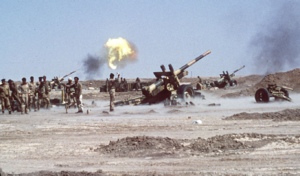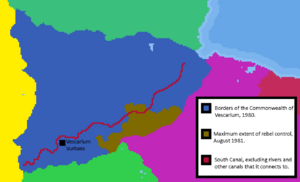South Canal Crisis: Difference between revisions
mNo edit summary |
|||
| Line 25: | Line 25: | ||
==Background== | ==Background== | ||
The Syndicalist Union of Vescarium had been a dominant force in underground politics and insurgent activity during the 1950's and 1960's, though by the late 1970's factionalism took hold, and the Union waned in power. These schisms had led to the splintering of [[Ciobanist]]-oriented militia groups, most notably the Free Army of Vescarium, away from the Union. These groups disliked the decentralized, syndicalist policies of the Union, and preferred staunchly authoritarian agrarian socialism instead. Paradoxically, the FAV was most popular in the southern deserts, where food was scarce and neglect of the irrigation systems by the Commonwealth government had spurred on local unrest. | |||
It was also during the 1970's that public hatred for the far-left began to cool, due to the aforementioned decline of the Union. While the SUV continued to remain a thorn in the government's side, anti-syndicalist policies were slowly beginning to disappear. Naturally, non-SUV groups such as the FAV were eager to capitalize on this. FAV influence spread throughout the Far South, with the exception of the industrial region of the southwest. Included in that area was Vescarium Vurbaes, the nation's capital, which still housed very stringent anti-syndicalist sentiments. | |||
===Leadup to Rebellion=== | ===Leadup to Rebellion=== | ||
Revision as of 05:17, 20 May 2021
| South Canal Crisis | |||||||
|---|---|---|---|---|---|---|---|
 Rebel artillery shelling Vescarian positions near the South Canal, July 1981. | |||||||
| |||||||
| Belligerents | |||||||
| Commonwealth of Vescarium |
Free Army of Vescarium Pomaz's Mutiny | ||||||
| Commanders and leaders | |||||||
|
Cornelius Trajanus † Laurențiu Viteazu Gaius Miloslavus Sternacius Cicero (After August 3) |
Aszod Pomaz Claudius Aurelius Viorica Mureșanu Sternacius Cicero (Before August 3) | ||||||
| Units involved | |||||||
| Vescarian Armed Forces |
Free Army of Vescarium Pomaz's Mutiny | ||||||
| Strength | |||||||
| 14,950 personnel |
8,200 soldiers 4,000 militiamen | ||||||
| Casualties and losses | |||||||
|
1,040 killed 165 wounded |
3,730 killed 270 wounded 3,291 captured | ||||||
The South Canal Crisis was a short-lived military mutiny turned open revolution that occurred within Vescarium in 1981. When agrarian-communist Aszod Pomaz was granted control of the 19th and 25th Infantry Brigades of the Vescarian Armed Forces in January of 1981, he conspired with his ideological colleague Claudius Aurelius, who was in control of the 9th Artillery Brigade, to overthrow the government by capturing the vital South Canal waterway, which provides fresh water to the capital city of Vescarium Vurbaes. They were also joined by the Free Army of Vescarium, an agrarian-collectivist left-terror militia unaffiliated with the Syndicalist Union of Vescarium, who offered to provide extra manpower for the inevitable uprising. When the Crisis began in April of 1981, the Vescarian army was taken by surprise, and hastily scrambled to retaliate. Their initial counteroffensives failed due to incredibly poor organization and suicidal tactics. However, as the weeks passed, the Vescarian army began to slowly learn from it's mistakes, and by the end of July it was clear that the revolt would inevitably fail. Sternacius Cicero, one of the commanders of the Free Army of Vescarium, defected to the government on August 3, signalling the beginning of the end for the revolution. The Crisis would not end until October, when Pomaz himself was captured by PRI agents, causing his army to collapse and offer unconditional surrender on October 24.
Background
The Syndicalist Union of Vescarium had been a dominant force in underground politics and insurgent activity during the 1950's and 1960's, though by the late 1970's factionalism took hold, and the Union waned in power. These schisms had led to the splintering of Ciobanist-oriented militia groups, most notably the Free Army of Vescarium, away from the Union. These groups disliked the decentralized, syndicalist policies of the Union, and preferred staunchly authoritarian agrarian socialism instead. Paradoxically, the FAV was most popular in the southern deserts, where food was scarce and neglect of the irrigation systems by the Commonwealth government had spurred on local unrest.
It was also during the 1970's that public hatred for the far-left began to cool, due to the aforementioned decline of the Union. While the SUV continued to remain a thorn in the government's side, anti-syndicalist policies were slowly beginning to disappear. Naturally, non-SUV groups such as the FAV were eager to capitalize on this. FAV influence spread throughout the Far South, with the exception of the industrial region of the southwest. Included in that area was Vescarium Vurbaes, the nation's capital, which still housed very stringent anti-syndicalist sentiments.
